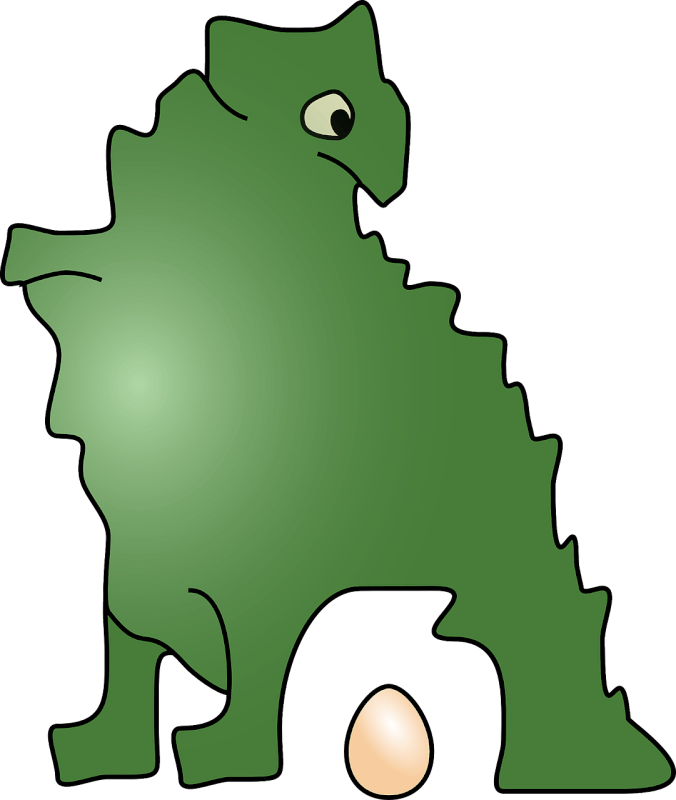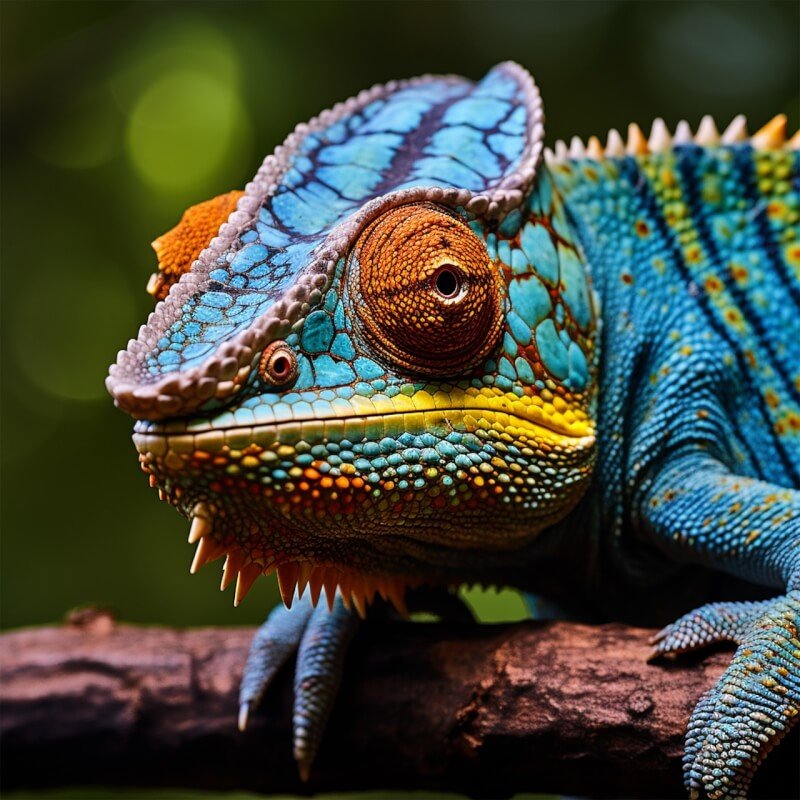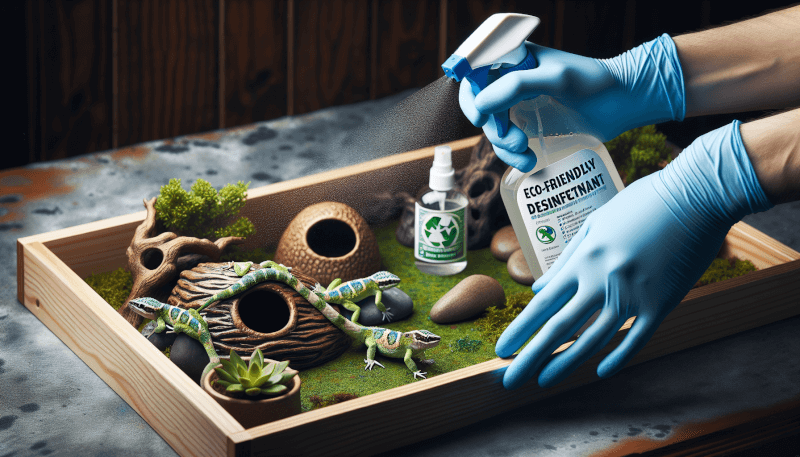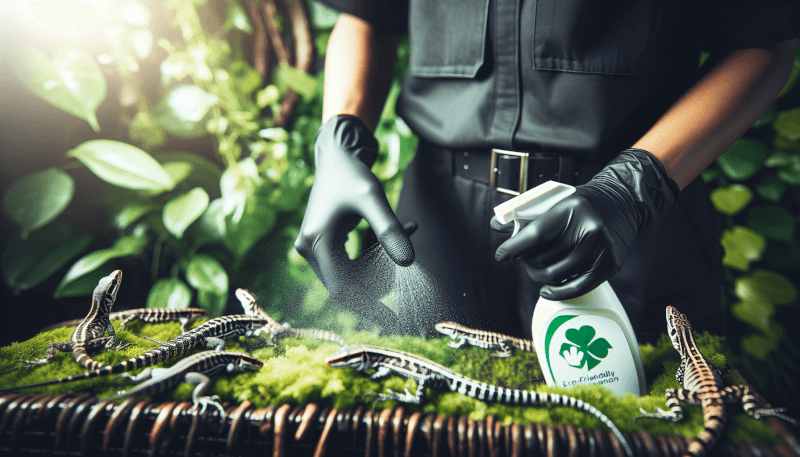If you want to make sure your reptile friend has a clean and healthy living space, it’s essential to know how to safely clean and disinfect their enclosure. Maintaining a clean environment not only keeps your reptile happy and thriving, but it also helps prevent the spread of disease and illness. In this article, we’ll walk you through some easy and effective steps to ensure your reptile’s home is spotless and germ-free, so you can enjoy many happy and healthy years together.
Choosing the Right Cleaning Supplies
When it comes to cleaning your reptile’s enclosure, it is crucial to choose the right cleaning supplies. Researching and selecting pet-safe cleaning products is the first step towards ensuring the well-being of your scaly friend. Look for cleaning solutions that are specifically designed for reptiles, as these products are formulated to be safe and gentle on their sensitive skin.
Researching Pet-Safe Cleaning Products
Before purchasing any cleaning products, take the time to research and read reviews about different brands and their reptile-safe cleaning solutions. Look for products that are labeled as non-toxic and specifically formulated for use in reptile enclosures. These products are free from harmful chemicals that can potentially harm your reptile and are designed to effectively clean and disinfect their environment.
Avoiding Harsh Chemicals
When it comes to cleaning your reptile’s enclosure, it is essential to avoid using harsh chemicals. Many common household cleaning products contain ingredients such as bleach, ammonia, and phenols, which can be toxic to reptiles. These chemicals can irritate their skin and respiratory system, leading to serious health issues. Always opt for cleaning products that are specifically formulated for reptiles to ensure the safety of your scaly companion.
Using Natural Cleaning Agents
If you prefer an alternative to commercial cleaning products, you can also consider using natural cleaning agents. Vinegar diluted with water is an excellent option for cleaning reptile enclosures. It is a natural disinfectant that effectively kills bacteria and viruses. Additionally, hydrogen peroxide diluted with water can also be used to sanitize surfaces. However, always ensure that the concentrations of these natural cleaning agents are safe for reptiles before using them to clean their enclosure.
Preparing the Reptile Enclosure for Cleaning
Before you start cleaning the reptile enclosure, proper preparation is vital to ensure the safety of both you and your reptile.
Removing the Reptile and Any Accessories
The first step in preparing the reptile enclosure for cleaning is to remove your reptile and any accessories. Gently and carefully place your reptile in a secure and suitable temporary habitat, such as a reptile carrier or another enclosure. Remove any food and water dishes, decorative items, rocks, hides, or any other accessories from the enclosure.
Turning Off Heat Sources
Before you begin the cleaning process, ensure that all heat sources, such as heat lamps or heating pads, are turned off and disconnected if necessary. This will prevent accidents or injuries from occurring while you clean the enclosure.
Protecting Yourself with Gloves
To protect yourself from any potential contamination or contact with reptile waste, it is advisable to wear gloves when cleaning the enclosure. This will provide an additional layer of protection and help prevent the spread of any potential bacteria or diseases.

Removing Waste and Debris
Once the enclosure is prepared, it’s time to remove any waste and debris from the enclosure.
Using a Scoop or Tongs
To remove solid waste, such as feces or shedded skin, use a scoop or tongs specifically designed for reptile enclosure cleaning. Avoid using your bare hands to minimize the risk of contamination and protect yourself from any potential bacteria or parasites that may be present in the waste.
Cleaning Out Substrate
If your reptile enclosure has substrate, such as sand, wood shavings, or reptile carpet, it is essential to clean it thoroughly. Remove the substrate and dispose of it properly according to the guidelines provided by your local waste management authority. Clean the enclosure base and walls with mild soap and water, ensuring that no waste or debris is left behind.
Wiping Down Interior Surfaces
Once the waste and substrate have been removed, wipe down the interior surfaces of the enclosure with a reptile-safe disinfectant. Use a soft cloth or sponge to clean all surfaces thoroughly, including the walls, floor, and any additional fixtures. Pay extra attention to areas where waste or debris may have accumulated.
Cleaning and Disinfecting Interior Surfaces
Cleaning and disinfecting the interior surfaces of the reptile enclosure is crucial to maintain a safe and healthy environment for your reptile. It helps eliminate bacteria, viruses, and other potential harmful microorganisms.
Using a Reptile-Safe Disinfectant
Choose a reptile-safe disinfectant that is specifically formulated for use in reptile enclosures. These disinfectants are designed to effectively kill bacteria, viruses, and parasites while being safe for your reptile. Follow the instructions provided by the manufacturer for the proper dilution and application method.
Scrubbing with a Soft Brush
To ensure a thorough cleaning, use a soft brush to scrub the interior surfaces of the reptile enclosure. Pay attention to any areas that may have become soiled or are difficult to reach. Scrubbing will help remove any stubborn stains or residues and ensure that the disinfectant reaches all parts of the enclosure.
Allowing Sufficient Contact Time for Disinfection
After scrubbing the interior surfaces, allow the disinfectant to remain on the surfaces for the recommended contact time. This will ensure that the disinfectant effectively kills any bacteria or viruses present. Avoid placing your reptile back into the enclosure until the disinfection process is complete and the enclosure has been thoroughly rinsed and dried.

Cleaning and Disinfecting Accessories
In addition to the enclosure itself, it’s important to clean and disinfect any accessories, such as food and water dishes, decorative items, and rocks or hides.
Separate Cleaning for Food and Water Dishes
Food and water dishes should be cleaned separately to avoid any cross-contamination. Wash the dishes with hot water and a mild reptile-safe soap or use a dishwasher if the dishes are dishwasher safe. Rinse the dishes thoroughly to remove any soap residue before placing them back in the enclosure.
Cleaning Decorative Items
When cleaning decorative items, such as artificial plants or branches, carefully wash them with hot water and a reptile-safe soap. Use a soft brush or cloth to remove any dirt or debris. Rinse the items thoroughly to ensure that no soap residue remains before returning them to the enclosure.
Washing Rocks and Hides
Rocks and hides can harbor bacteria or parasites, so it’s important to clean them regularly. Wash the rocks and hides with hot water and a reptile-safe soap. Use a soft brush to remove any debris or waste, paying attention to any crevices or textured surfaces. Rinse the rocks and hides thoroughly and allow them to dry completely before placing them back in the enclosure.
Rinsing and Drying the Enclosure
Thoroughly rinsing and drying the reptile enclosure is essential to ensure the removal of any cleaning agents and moisture.
Thoroughly Rinsing with Water
After the disinfection process is complete, thoroughly rinse the enclosure with water. This will help remove any residue from the cleaning products, ensuring the safety of your reptile. Pay close attention to all surfaces, ensuring that no cleaning product remains.
Removing Excess Water
To prevent excess moisture and maintain a suitable environment for your reptile, remove any excess water from the enclosure. Use a cloth or sponge to absorb the water, paying attention to any hard-to-reach areas. You can also use a reptile-safe vacuum or a paper towel to soak up any remaining moisture.
Allowing Adequate Drying Time
Once the excess water has been removed, allow the enclosure to air dry completely before reintroducing your reptile or any accessories. Proper drying time is crucial to prevent the growth of mold or mildew, which can pose a risk to your reptile’s health. Ensure that the enclosure is completely dry before proceeding.

Monitoring and Maintaining Cleanliness
Regular monitoring and maintenance are essential to ensure the cleanliness of your reptile’s enclosure.
Regular Spot Cleaning
Make it a habit to perform regular spot cleaning in your reptile’s enclosure. This involves removing any waste or debris that may accumulate between regular cleaning sessions. Regularly check the enclosure for any signs of soiling or contamination and address them promptly.
Consistent Substrate Changes
If your reptile’s enclosure has substrate, such as sand or wood shavings, it’s important to change it regularly. The frequency of substrate changes will depend on the type of reptile and the specific substrate used. Regularly clean the enclosure base and replace the substrate to maintain cleanliness and prevent odor buildup.
Preventing Mold and Mildew Growth
To prevent the growth of mold and mildew, ensure that the reptile enclosure is properly ventilated. Avoid excessive moisture by providing proper drying time after cleaning, and monitor the humidity levels in the enclosure. Regularly check for any signs of mold or mildew growth, and take prompt action if necessary.
Cleaning the Surrounding Area
During the cleaning process, it’s important to also clean the surrounding area to maintain a clean and hygienic environment for both you and your reptile.
Protecting the Cleaning Area
Before starting the cleaning process, protect the area surrounding the reptile enclosure. Lay down plastic sheets or newspapers to catch any debris or water that may splash or drip during the cleaning process. This will facilitate easy cleanup and prevent any damage to your flooring or furniture.
Cleaning Up Loose Debris
After cleaning the reptile enclosure, make sure to clean up any loose debris that may have fallen or been scattered outside the enclosure. Use a handheld vacuum or sweep the area with a broom and dustpan to ensure that the surrounding area remains clean.
Disinfecting Surfaces
To maintain a hygienic environment, it is advisable to disinfect any surfaces in the surrounding area that may have come into contact with reptile waste or cleaning products. Use a reptile-safe disinfectant or a mixture of vinegar and water to clean and disinfect these surfaces, following the manufacturer’s instructions for proper dilution and application.

Dealing with Specific Contaminants
While cleaning the reptile enclosure, you may encounter specific contaminants that require special attention and care.
Removing Shedded Skin
Shedded skin is a natural occurrence for reptiles, but it can accumulate and create an unsanitary environment if not removed. Carefully remove any shedded skin using tweezers or gentle fingers. Be cautious not to damage any newly regrown skin during the process, as it can be fragile.
Dealing with Fecal Matter
Fecal matter is a common contaminant found in reptile enclosures and should be promptly removed. Use a scoop or tongs to carefully remove solid feces, ensuring that you avoid direct contact with the waste. Dispose of the waste properly and sanitize the affected area using a reptile-safe disinfectant.
Cleaning Up Regurgitated Food
If your reptile regurgitates its food, it’s important to clean up the mess promptly. Use gloves and clean the affected area with a reptile-safe disinfectant, ensuring that all residue is removed. Regurgitation can be a sign of an underlying health issue, so consult with a reptile veterinarian if it becomes a recurring problem.
Ensuring Personal Safety
When cleaning and disinfecting a reptile enclosure, it is essential to prioritize your personal safety.
Wearing Protective Equipment
Always wear gloves and any other necessary protective equipment, such as goggles or a mask, to prevent direct contact with reptile waste and potential exposure to harmful pathogens. Protective equipment provides an additional layer of protection and reduces the risk of contamination.
Avoiding Contact with Reptile Waste
To minimize the risk of pathogens, it is crucial to avoid direct contact with reptile waste. Use appropriate tools, such as scoops or tongs, to handle solid waste and dispose of it properly. Always wash your hands thoroughly after handling reptile waste, even when wearing gloves.
Proper Hand Hygiene
Proper hand hygiene is essential when handling reptiles and cleaning their enclosures. Wash your hands thoroughly with warm water and antibacterial soap before and after handling your reptile or cleaning their enclosure. This will help prevent the spread of any potential bacteria or diseases.
By following these comprehensive cleaning tips, you can create a safe and hygienic environment for your reptile. Regular cleaning and maintenance will not only keep your reptile healthy but also ensure your own well-being. Remember to choose the right cleaning supplies, prepare the enclosure properly, and maintain cleanliness consistently. With these steps, you can enjoy a happy and healthy life with your reptilian companion!


